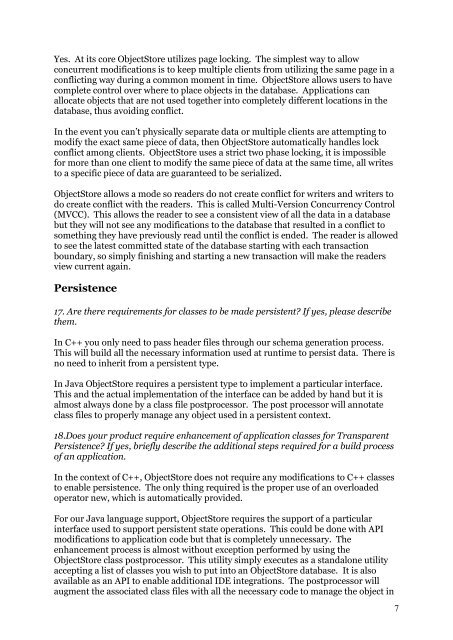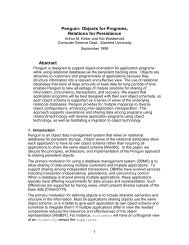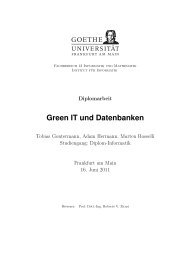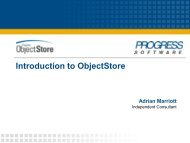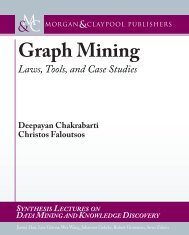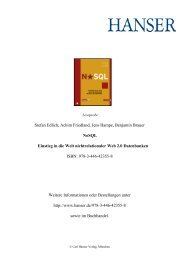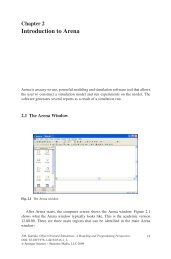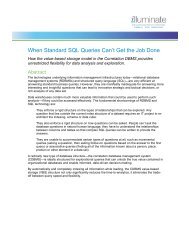TechView Product Report: ObjectStore - ODBMS
TechView Product Report: ObjectStore - ODBMS
TechView Product Report: ObjectStore - ODBMS
Create successful ePaper yourself
Turn your PDF publications into a flip-book with our unique Google optimized e-Paper software.
Yes. At its core <strong>ObjectStore</strong> utilizes page locking. The simplest way to allow<br />
concurrent modifications is to keep multiple clients from utilizing the same page in a<br />
conflicting way during a common moment in time. <strong>ObjectStore</strong> allows users to have<br />
complete control over where to place objects in the database. Applications can<br />
allocate objects that are not used together into completely different locations in the<br />
database, thus avoiding conflict.<br />
In the event you can’t physically separate data or multiple clients are attempting to<br />
modify the exact same piece of data, then <strong>ObjectStore</strong> automatically handles lock<br />
conflict among clients. <strong>ObjectStore</strong> uses a strict two phase locking, it is impossible<br />
for more than one client to modify the same piece of data at the same time, all writes<br />
to a specific piece of data are guaranteed to be serialized.<br />
<strong>ObjectStore</strong> allows a mode so readers do not create conflict for writers and writers to<br />
do create conflict with the readers. This is called Multi-Version Concurrency Control<br />
(MVCC). This allows the reader to see a consistent view of all the data in a database<br />
but they will not see any modifications to the database that resulted in a conflict to<br />
something they have previously read until the conflict is ended. The reader is allowed<br />
to see the latest committed state of the database starting with each transaction<br />
boundary, so simply finishing and starting a new transaction will make the readers<br />
view current again.<br />
Persistence<br />
17. Are there requirements for classes to be made persistent? If yes, please describe<br />
them.<br />
In C++ you only need to pass header files through our schema generation process.<br />
This will build all the necessary information used at runtime to persist data. There is<br />
no need to inherit from a persistent type.<br />
In Java <strong>ObjectStore</strong> requires a persistent type to implement a particular interface.<br />
This and the actual implementation of the interface can be added by hand but it is<br />
almost always done by a class file postprocessor. The post processor will annotate<br />
class files to properly manage any object used in a persistent context.<br />
18.Does your product require enhancement of application classes for Transparent<br />
Persistence? If yes, briefly describe the additional steps required for a build process<br />
of an application.<br />
In the context of C++, <strong>ObjectStore</strong> does not require any modifications to C++ classes<br />
to enable persistence. The only thing required is the proper use of an overloaded<br />
operator new, which is automatically provided.<br />
For our Java language support, <strong>ObjectStore</strong> requires the support of a particular<br />
interface used to support persistent state operations. This could be done with API<br />
modifications to application code but that is completely unnecessary. The<br />
enhancement process is almost without exception performed by using the<br />
<strong>ObjectStore</strong> class postprocessor. This utility simply executes as a standalone utility<br />
accepting a list of classes you wish to put into an <strong>ObjectStore</strong> database. It is also<br />
available as an API to enable additional IDE integrations. The postprocessor will<br />
augment the associated class files with all the necessary code to manage the object in<br />
7


